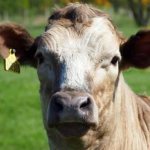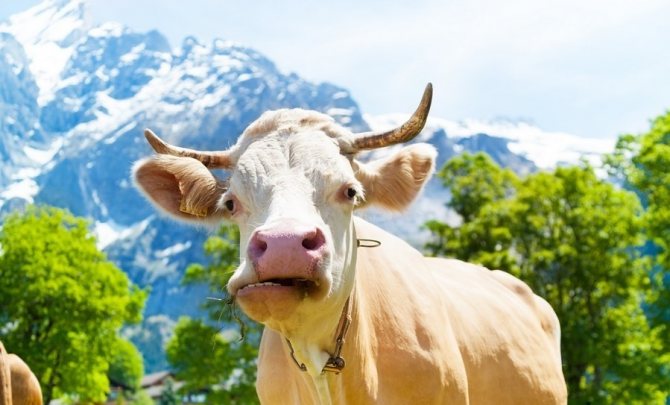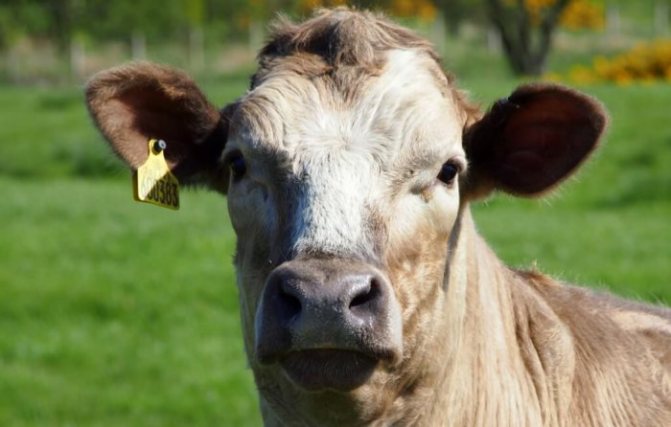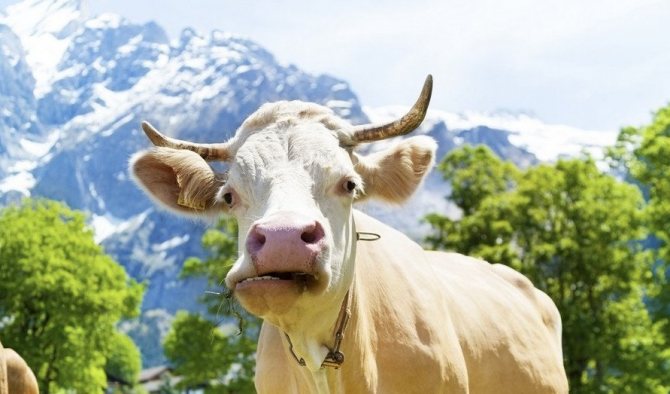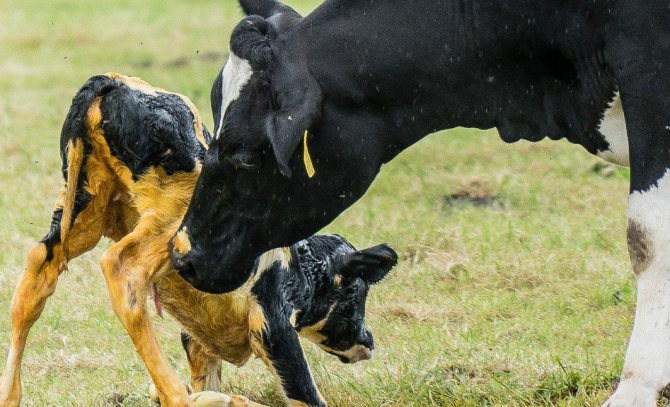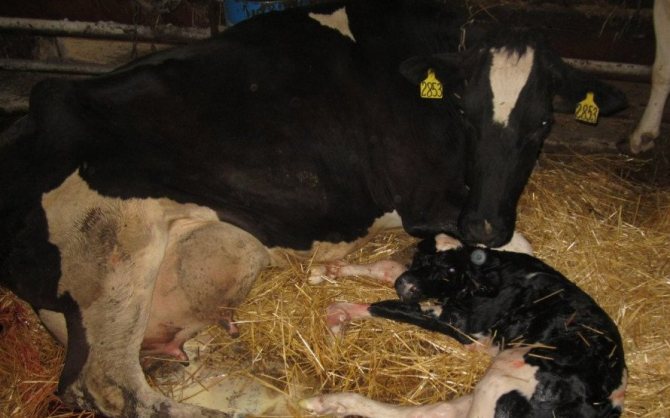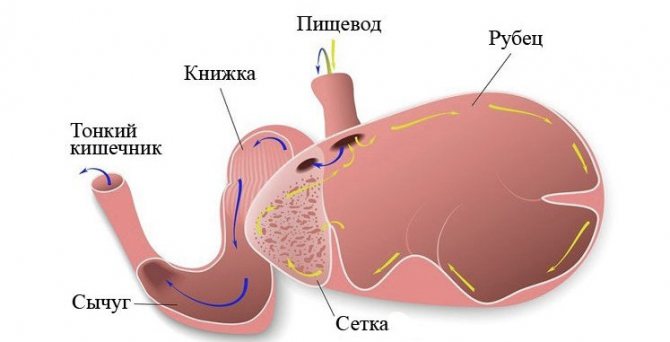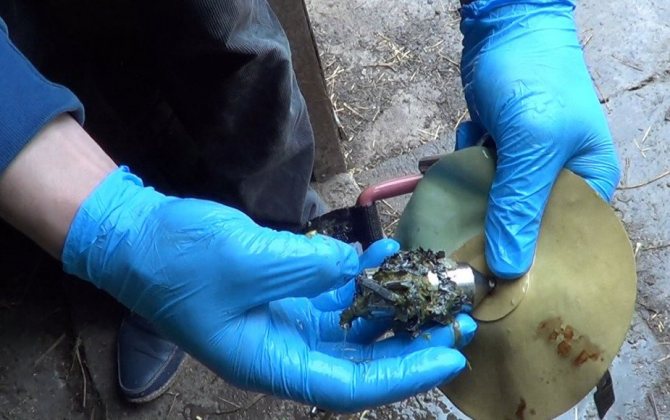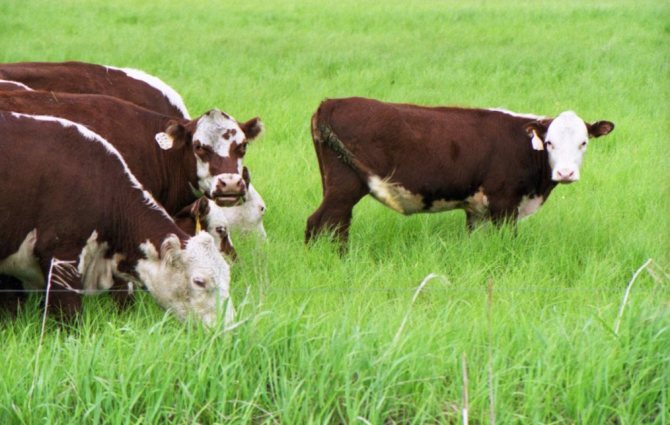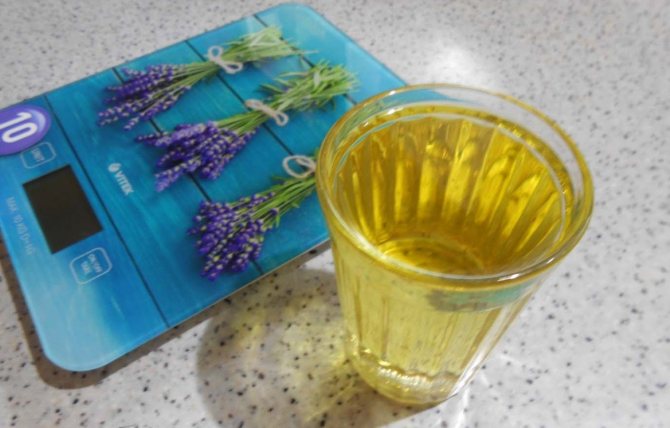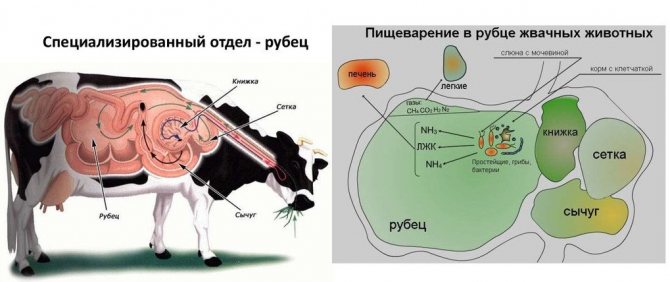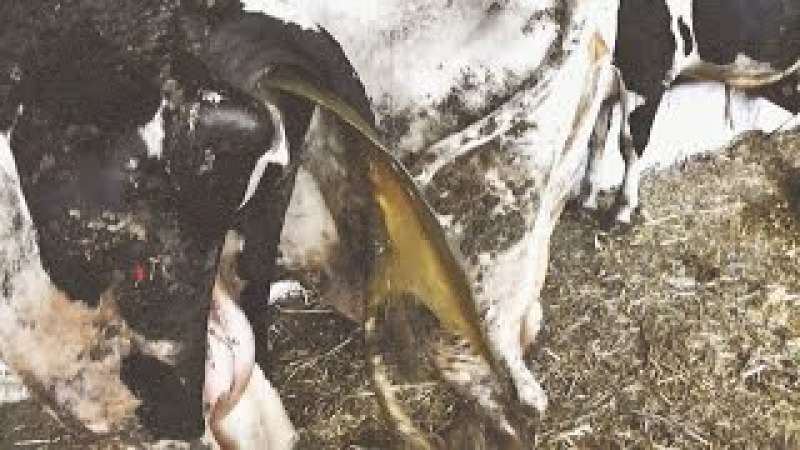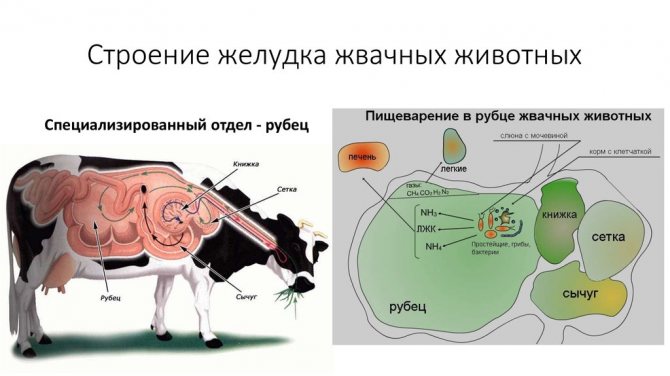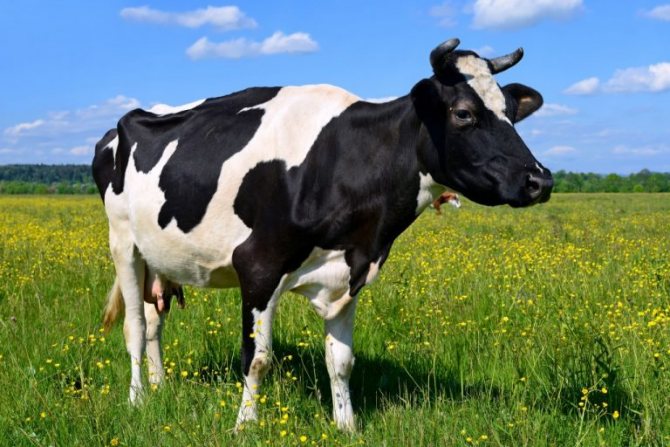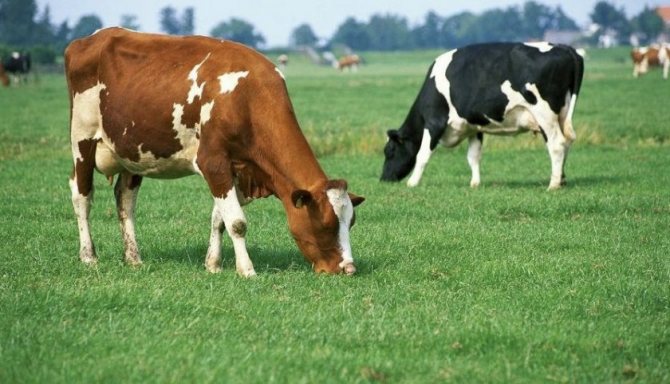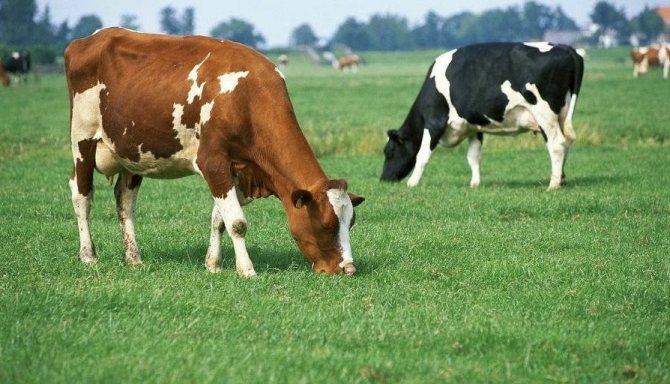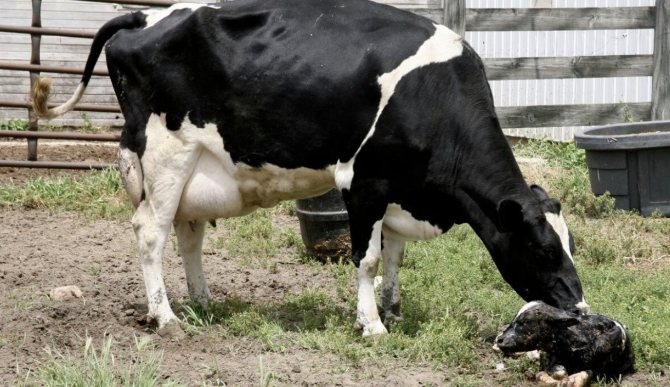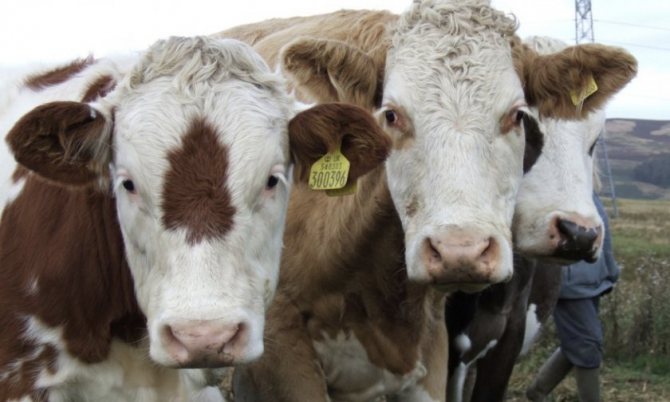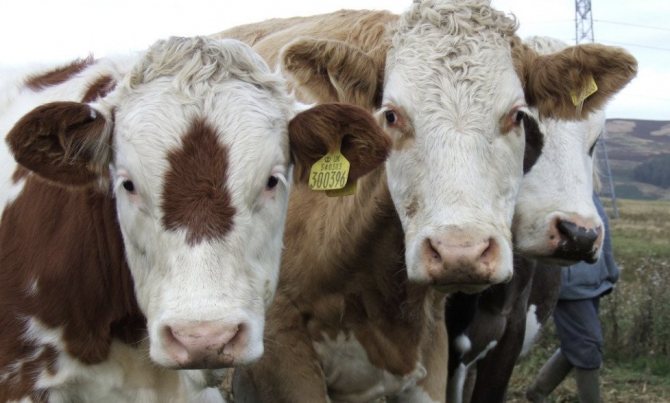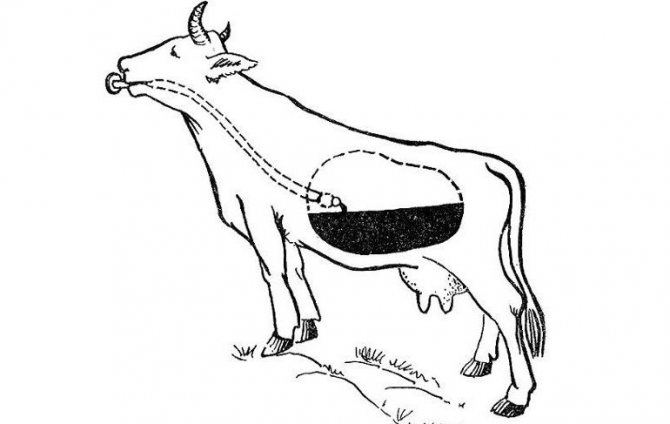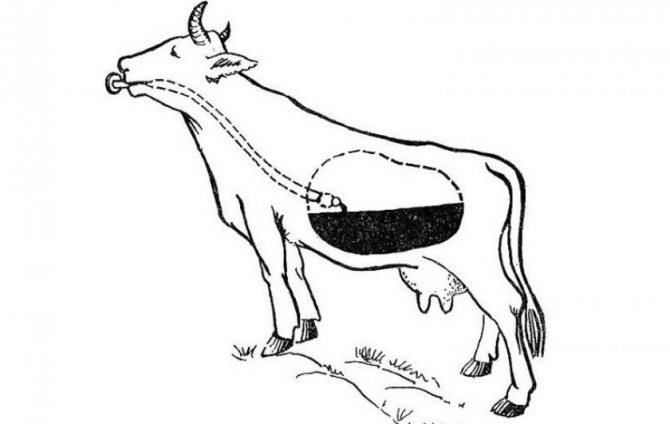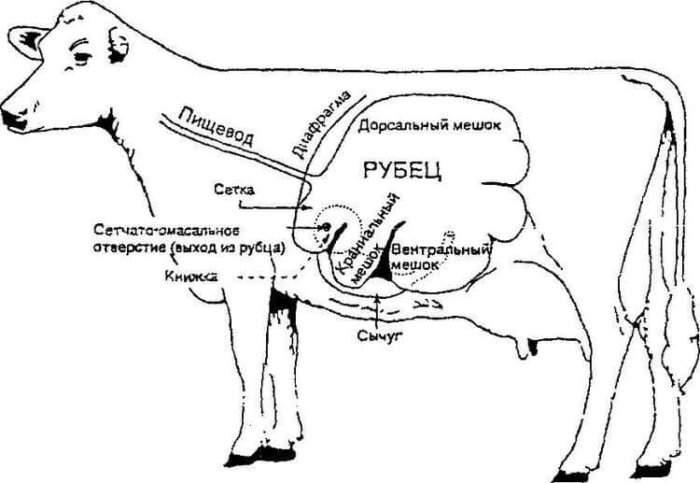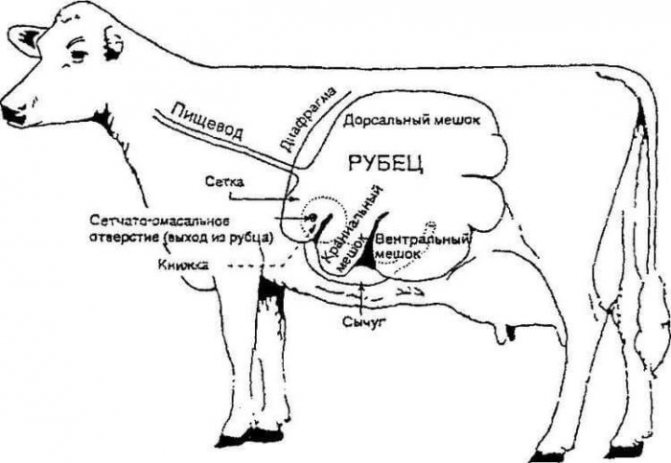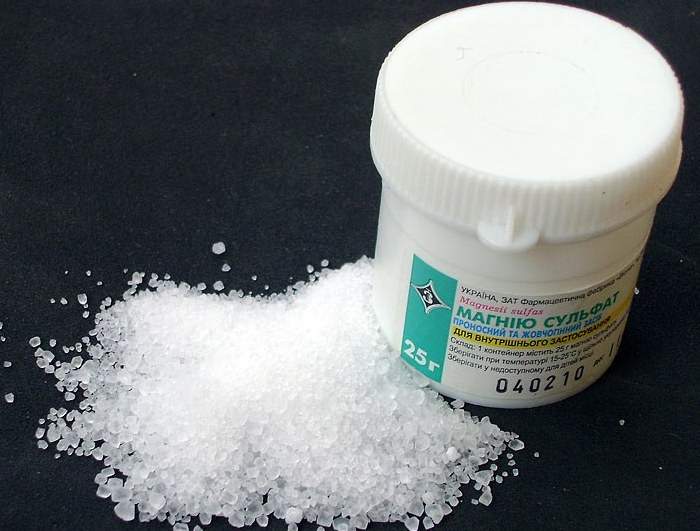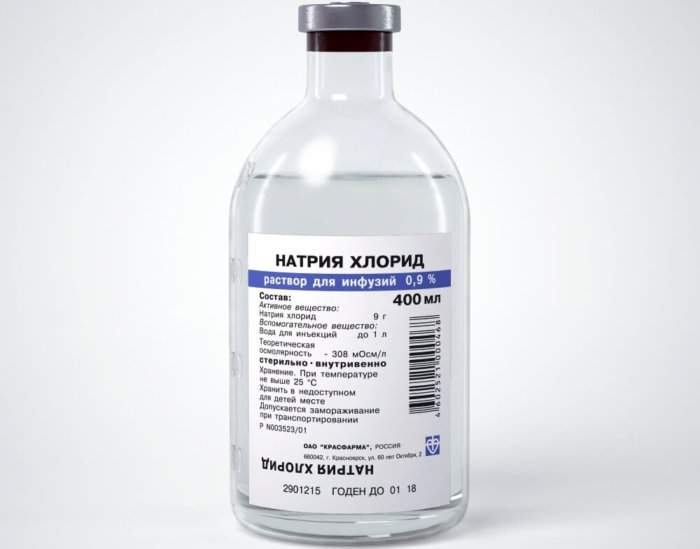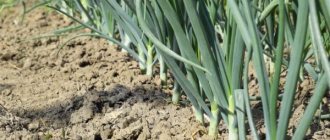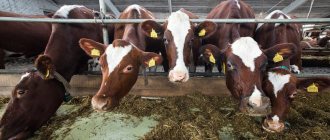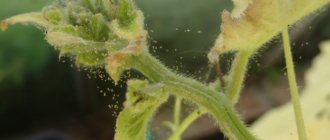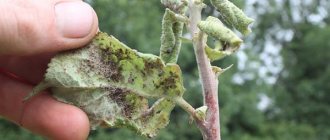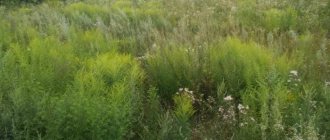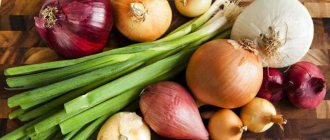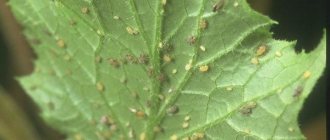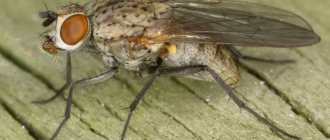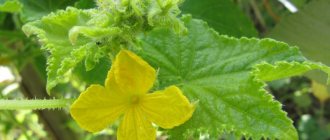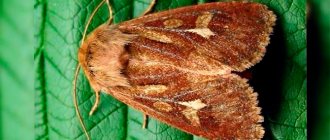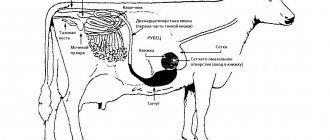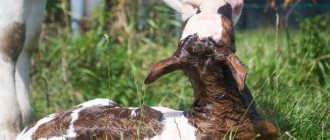The absence of chewing gum in a cow is a dangerous symptom, it speaks of a malfunction of the animal's stomach. Noticing that the calf has lost its chewing gum, the farmer should figure out what happened and try to help him. The reasons for the lack of chewing gum in cows and methods of treatment will be discussed in this article.
Lack of gum in a cow
Why do cows chew all the time?
Chewing gum by a cow is explained by the structural features of her stomach. As an extension of the esophagus, the stomach accumulates, mixes, digests food and forms a mushy mass (chyme). It is this chyme that moves into the small intestine.
Important: Observe the behavior of the animal - emotional stress can often be the reason for the loss of gum. In this case, it is necessary to create the most favorable conditions for keeping the cow in order to prevent the development of more serious diseases.
In the process of digestion, complex substances are broken down into simple ones. This is facilitated by the effects of saliva and gastrointestinal enzymes. Many people believe that the absorption processes are carried out precisely in the stomach, but in fact the process of food digestion ends when it enters the cecum.
There are several types of stomachs: single-chamber (dogs, pigs, humans have them) and multi-chamber. Cows are the owners of the second type and have a stomach, which consists of four chambers. It is this fact that makes the process of eating food in these animals quite difficult.
The structure of the stomach of a cow
- The largest section is the scar, represented by a sac-shaped organ. Its volume can reach 200 liters. It accumulates food and its further digestion, for which enzymes of ciliates are needed (they are symbionts of the stomach).
- After the scar, the food lump moves through the mesh into the section called the book. The mesh acts as a kind of filter that can only allow liquids to pass through. The gum will regurgitate until food can seep through the mesh.
- Due to the presence of an acidic environment in the book, there are no ciliates in it. Acid enters this section from the abomasum, after which the muscles contract, and the feed is frayed.
- The abomasum is the glandular part of the stomach, digestion in this part is carried out according to the scheme that is inherent in a monocameral stomach.
In the process of digestion, complex substances are broken down into simple ones. This is facilitated by the effects of saliva and gastrointestinal enzymes. Many people believe that the absorption processes are carried out precisely in the stomach, but in fact the process of food digestion ends when it enters the cecum.
These animals became ruminants in the course of evolution. They did not have claws, sharp fangs and other attributes of protection from predators, so they had to quickly grab and swallow food, and then chew it in a safe place and receive useful substances.
As a result, their bodies have adapted to this lifestyle by changing the structure of the gastrointestinal tract.
Rapid swallowing of plant food did not allow getting all the nutrients from it, so the stomach "learned" to return the lump to the oral cavity for thorough chewing and enrichment with saliva.Such a system simplified and accelerated further digestion and excretion of vitamins, sugars and enzymes from the plant mass. Over time, the cow's digestive organ split into several chambers.
Did you know? Cows and humans have lived together for 8 thousand years.
In the modern cow, chewing gum is due to the special structure of the stomach. Unlike other (non-ruminant) animals and humans, cattle must get complex sugars from hard plant foods, which are found in fiber. In order to obtain such sugars, a complex structure of the stomach is required - cows have 4 chambers, each of which performs its own function.
There are such sections:
- scar;
- grid;
- book;
- abomasum.
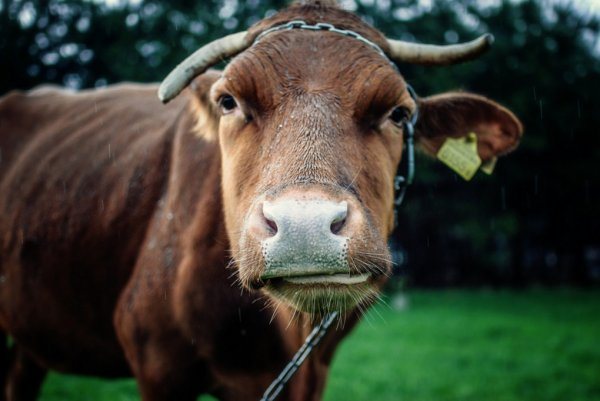
The structure of the stomach of a cow Chewed grass falls into the rumen, which is the largest chamber, its volume reaches 200 liters in a healthy adult animal. In this chamber, beneficial bacteria live on the mucous membrane that aid in digestion. Bacteria, together with saliva, decompose food and prepare it for return to the oral cavity and processing in the following chambers.
Did you know? A cow's jaws perform 30 to 90 chewing movements in 1 minute.
The second stage of digestion is the mesh of the stomach. Well-crushed gum gets here. Then the herb, brought to a certain condition, goes into the book. Here a volume of food equal to 10 liters is placed, and the walls absorb water, sodium and phosphorus from the grass. Only after passing through all these stages, food is sent to the abomasum and further along the digestive tract.
Precautions
To prevent the occurrence of these and other consequences from overeating the crushed grain, it is necessary to follow the cattle nutrition standards and store feed only in places that are difficult for cattle to reach.
The cow's diet must be balanced. This means that during the day she should receive compound feed, liquid food, silage, and vitamins. Therefore, you should take full responsibility for the preparation and storage of feed, rejection of spoiled products. And also give the right amount of water, especially in the winter season. Do not forget about the daily exercise of cattle.
We suggest you read: How to treat udder edema in a cow
It is important to keep order in the barn - it should be cleaned regularly. Feed for young animals needs careful grinding. It is not necessary to leave calves without food for a long time, so that hunger does not arise, and they do not pounce on food.
Often, diseases of the gastrointestinal tract appear after grazing. Therefore, you must adhere to the following rules:
- feed the cattle before the walk with roughage;
- choose a poor pasture;
- if there is a lot of grass, then animals graze for about 1 hour, no more;
- drive the cattle after eating;
- be sure to send the cows to the reservoir.
If you use these methods of prevention, then you will avoid problems with the stomach and breathing of the animal.
Swallows first, then chews
People have been raising cattle for centuries. They observed and gradually studied the digestive system of animals that chewed constantly. It turned out that the stomach of a cow is very complex. There is a version that evolution influenced the formation of this organ for many thousands of years.
The wild cow, unable to stand up for herself, quickly grabbed food, swallowed and hid from predators in a secluded place. And only then did she begin to chew, as if during a rest. At first glance, it is not clear how you can first swallow and then chew. However, the danger of a situation when suddenly a cow's gum disappeared becomes clear if you disassemble the process on the shelves.
To understand why there are so many of them, it is necessary to disassemble the function of each, plus consider the work of the intestine as an important organ of the digestive tract.Only then can you clearly imagine what happens to a cow chewing for several hours a day.
Prophylaxis
These diseases are easier to prevent than to treat animals later, therefore experienced livestock breeders observe the following rules:
- Proper care of animals. A common cause of stomach pathologies is a violation of the rules for keeping and feeding cattle.
- Preparing and inspecting pastures for hard and sharp objects, poisonous plants, as well as refusal to graze cows immediately after rain or when there is abundant dew.
- If a tethered type of maintenance is chosen, then the owners of the animal should take care of the active exercise of the cow, about the presence of an abundant watering hole.
- Regular examination of animals by a veterinarian.
Prevention, active walking and quality feed, in conjunction with regular veterinary examinations, will help to avoid dangerous conditions in animals.
Symptoms of Hypotension and Atony in Cows
Depending on the reason the calf does not have gum, the treatment prescribed will vary. Among the pathologies that cause its absence, we call atony, in which the reduction of the scar stops. The reasons can be:
- abrupt transfer of the calf to another feed, for example, from juicy to coarse;
- eating too much husk from any grains;
- use of low-quality grain for feeding young animals;
- excess chaff in the diet;
- other diseases causing atony as a side effect.
If this pathology is immediately recognized, then it can be easily cured in 5-6 days. The sick person is put on a starvation diet, that is, the first two days are given nothing but water. Twice a day, infusion of hellebore 10 ml is poured inside at a time. Intravenous injections of sodium chloride (5%) are given. You may need from 300 to 500 ml of solution. To stop the processes of fermentation in the stomach, use the drug "Macerobacillin". Dosage - no more than 10 g per day.
Hypotension and scar atony are not contagious. With hypotension, the motility of the scar is reduced. With atony, it is absent. How to recognize diseases?
- Animals stop chewing.
- Cows refuse to feed.
- The scar is full. At the beginning of the disease, the abdomen in the area of the scar is dense. Then he relents. Stagnation of feed occurs. Microorganisms and bacteria die in the rumen. The decay process begins.
- Gas accumulates in the hungry fossa: a specific sound is noted when tapped.
- Noises in the rumen are weak.
- Animals are lethargic, do not want to get up.
- Body temperature is normal.
- Breathing and pulse are quickened.
- With a prolonged course of the disease, toxins from the rumen spread throughout the body. Cows have muscle cramps. The body temperature decreases, tachycardia develops.
If treatment begins with the appearance of the first symptoms, then the restoration of the motility of the scar and other parts of the stomach occurs within 3-5 days. In advanced cases, the duration of therapy is 15 days. Sometimes hypotension and atony become chronic.
This disease is caused by abnormal contraction of the pre-ventricles. Symptoms of the disease appear quickly and can provoke early death. In this case, one should not waste time on experiments and self-medication, but rather call a veterinarian.
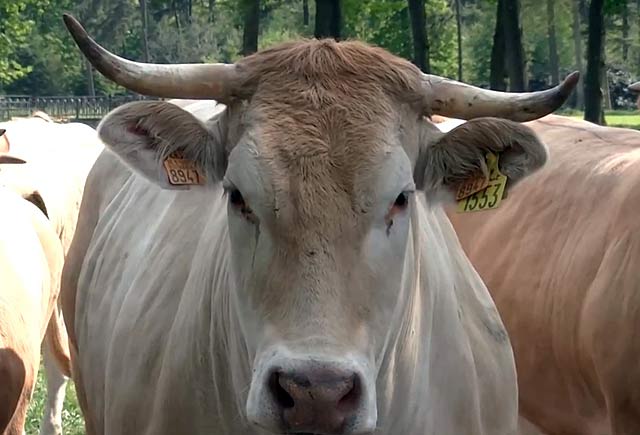

With atony, the cow does not have chewing gum and completely refuses to feed. In the absence of the possibility of feeding, the stomachs cease to function, then the digestive tract and the animal dies.
Read more: Azofoska for potatoes: application of fertilizer
Hellebore tincture helps well with atony. This remedy is sold at any pharmacy. 2 ml of the substance is dissolved in 400 ml of water. To treat the animal is as follows: pour the prepared solution into the mouth, then after 20 minutes introduce this dose again.This remedy irritates the stomach lining, causes belching, and helps bring back the gum.
Additionally, the veterinarian should give an intramuscular injection of a 0.1% concentration of carbokhalin solution. The introduction is twice with an interval of 20 minutes. To prevent gas formation and the fermentation process in the stomach, the drug Macerobacillin is used. The maximum dose is 10 g.
Atony in a cow
Gum formation
If a cow, for example, eats grass, then the greens through the esophagus enter the rumen - this is the first part of the stomach (proventriculus). It is here that the consumed products are fermented, that is, they are already slightly processed.
This is the largest part of the stomach, the capacity can reach 200 liters in an adult cow. In a normally developed calf, the scar makes up 80% of the total volume of all sections. You can read about how the baby eats, why he loses his appetite and, in general, about the gastric processes in young cattle in the article "How to treat a calf if it has lost its gum."
The second compartment where food gets into is called the mesh. Through it, the crushed products pass further along the path. And then the gum itself is formed, which looks like balls. In these first two sections, fermentation takes place, that is, after the breakdown of carbohydrates, fatty acids (volatile) are formed. Gas in the stomach, one of which is high-energy methane, promotes belching.
Acidosis
If the cow is not chewing gum, she may have developed a condition called acidosis. This sore provokes food with high or low pH levels in the rumen. This pathology develops in both adults and young animals, and is often the result of death.
Treatment of acidosis is prescribed by a veterinarian. Each case has its own scheme and drugs.
For the purpose of prevention, it is worth excluding sour, hard foods from the diet, which contribute to a change in the level of acidity in the stomach.
Reasons for missing gum
So, the absence of chewing gum is a symptom that cannot be ignored, it indicates a disruption in the work of the cow's digestive system. Let's consider the main reasons for the loss of gum in calves:
- Atony.
- Tympany.
- Traumatic reticulitis.
Each of these conditions is dangerous for the cow. In the process of getting acquainted with these diseases, it will become clear why.
Atony
A decrease in the contractility of the stomach or its complete absence is called atony. If the muscles of the proventriculus stop contracting, food stagnates in the rumen, and the digestion process stops. This condition poses a threat to the cow - intestinal obstruction and tympania, that is, bloating, may develop. Reasons for stopping motor activity of the stomach:
- Abrupt change in calf diet.
- Poor quality feed, such as hay or grain affected by mold.
- Eating large amounts of juicy feed or concentrates.
- Drinking poor quality water.
- Lack of exercise.
Treatment of atony is aimed at resuming motor activity of the stomach and preventing gas formation. On the first day, the calf should be kept on a starvation diet, while drinking is not limited. Massage helps to increase the tone of the muscles of the proventriculus. It is performed with a fist on the outer part of the peritoneum in the area of the hungry fossa.
Sodium chloride
Sodium chloride is injected intravenously. Already after a single injection, the contractile ability of the proventriculus is noticeably increased.
Tympany
Swelling of the scar is called tympania. Increased gas production can occur as a result of blockage of the esophagus, atony of the stomach, and the predisposing factors are:
- Eating easily fermented feed.
- Overfeeding with concentrates.
- Eating poisonous plants by a cow.
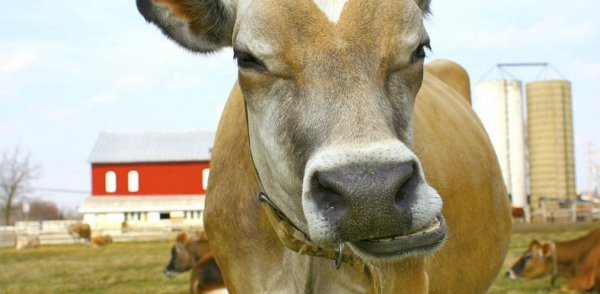

Tympania is life-threatening for the calf. Gas accumulating in the rumen increases the volume of the stomach, resulting in pressure on the diaphragm. At the same time, the cow suffers from a lack of oxygen.If you do not help her in time, death from asphyxia will occur.
Tympania is treated urgently if there are signs of oxygen starvation - blue discoloration of the mucous membranes, shallow breathing. In this case, the scar is punctured with a trocar. In other cases, massage the hungry fossa is used, pouring cold water over this area.
To stimulate the passage of gases, the cow is positioned so that the front of the body is higher than the back. Use a probe if needed. It makes it easier to remove gases from the rumen. Means help to reduce the concentration of gases in the rumen:
- Ichthyol solution.
- Magnesia.
- Ammonia solution.
- New milk.
Magnesia
The cow is kept on a starvation diet for 24 hours, after which the usual feed is gradually introduced into the diet.
If a cow does not chew gum, it is possible that she has traumatic reticulitis. This disease occurs when an animal swallows sharp objects and they injure and sometimes perforate the rumen wall. In this case, the stomach also stops working, and then tympania occurs. The foreign body that caused the loss of gum must be removed.
Treatment with folk remedies
If a cow has lost gum, you can try to cure it with folk remedies. Hellebore tincture helps to start the stomach if it stops. Calves are given 10 ml of the product to drink, after dissolving it in half a liter of water. Adults are given 15 ml of hellebore tincture.
Such folk remedies for starting the stomach will be no less effective:
- Cucumber pickle.
- Mineral water.
- Lactic acid.
- Decoction of chamomile or St. John's wort.
Attention! If none of the above has helped to resume chewing, the problem may only be resolved with surgery.
If you find that the calf has lost its gum, call your veterinarian to find out the reason. Help the animal as soon as possible, especially if there are signs of oxygen deficiency, which develops during tympania. Delay can lead to the loss of the animal.
Digestive disorders in cattle are quite common. Every livestock breeder should notice dangerous symptoms in time and provide assistance to a sick animal. Often farmers notice that the cow does not have gum. What to do in this case? What is the root of the problem? We recommend that you find out the possible causes and options for treating a cow using folk remedies.
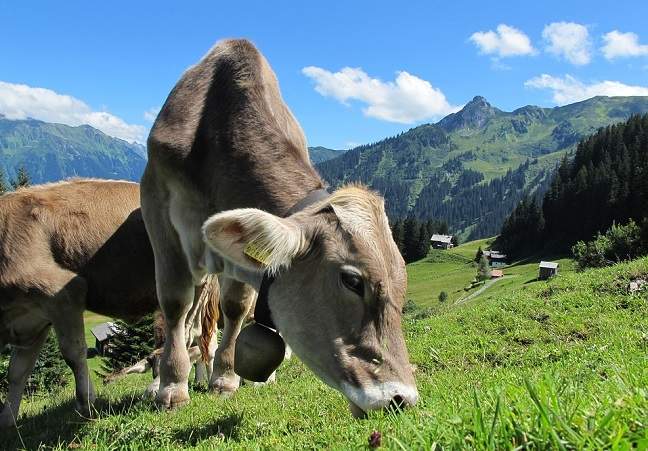

We suggest you find out what to do at home if the cow does not chew gum
Porridge is cooked in a book
Large pieces of food (balls) cannot pass through the mesh, and during belching through the esophagus, they fall back into the mouth. Scientifically, this phenomenon is called rumination. Actually, then the process of chewing in a cow begins. She eats, working hard with her jaws, until the food is completely chewed. At the same time, small pieces pass into the third section of the stomach, called a book.
This part of the digestive organ received this name due to the presence of sheets that look like book pages. They have a coarse, horny composition, which contributes to grinding any feed into a gruel.
Then the resulting mass passes into the abomasum - this is the last, but no less important part of the stomach. It has a glandular structure. In it, all food is processed by gastric juice, and proteins are assimilated. After that, all the contents are sent to the intestines, where the rest of the enzymes are absorbed into the blood.
Preventive measures
To exclude the lethargy of the digestive system or a complete stop of rumination, a number of preventive measures are taken in advance:
- all feed is carefully checked for the presence of foreign bodies;
- there should be a minimum amount of rough food in the diet;
- calves should not be fed large pieces of food;
- starvation of animals should not be allowed;
- keep livestock clean, preventing the development of diseases;
- subject cows to regular veterinary examinations.
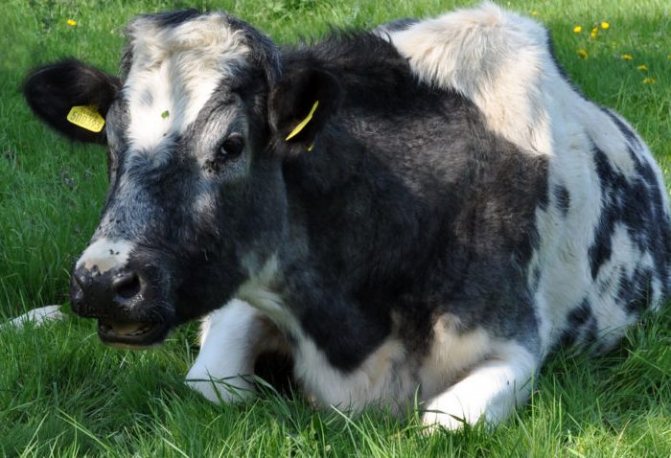

Cow
They are prepared for calving in advance, taking into account the possibility of pathological childbirth.
Tympany
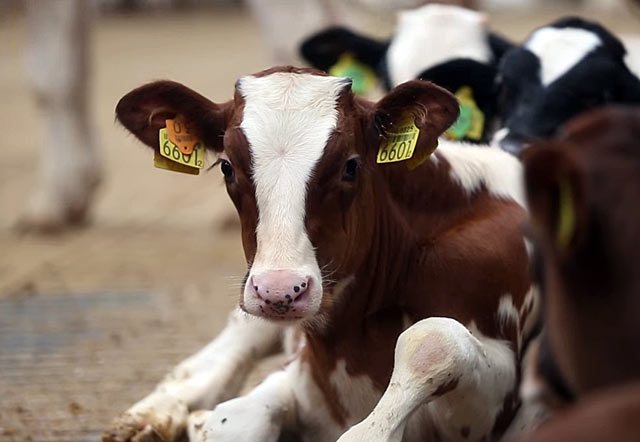

In this situation, there is a process of blockage of the esophagus and increased gas formation in the scar area. This phenomenon is called tympania, when the full functioning of the digestive system is disrupted. One of the obvious symptoms of the disease is that feeding on fresh grass leads to overeating of the animal. The same outcome is possible if the cow is fed stale, rotten or frozen food. Poor feeding puts a heavy strain on the digestive system, which provokes a blockage of the esophagus.
The reasons for the development of pathology:
- inexperience and carelessness of breeders;
- non-observance of the rules of feeding vegetables, fruits that enter the animal's stomach not crushed.
While chewing, the animal is not able to chew the root vegetable to a mushy consistency, as a result of which it almost entirely enters the esophagus. And this often provokes a blockage.
Causes of the failure of the digestive system
Now you know, if a cow does not have gum, then her stomach is up or is not working properly. The reasons for the failure can be:
- swelling of the scar (tympania);
- loss of scar, mesh and abomasum tone (atony);
- swallowing inedible objects (traumatic reticulitis);
- fetal pressure (in a pregnant cow) on the digestive organs.
Tympania can occur if animals chew on too much cabbage, corn or legumes, especially after rain. This feed can ferment in the stomach of the cow. The formation of large amounts of gas clogs the passages for the normal movement of food. As a result, the digestion process is disrupted and the cow does not chew.
Only a doctor can accurately determine tympanum. On his own, the farmer can only assume its occurrence, noting that the animal does not eat, does not drink, has lost its gum, hits the stomach with its hind legs and looks back at it. A "risen" stomach can lead to the death of the cow, so a veterinarian is urgently needed to release the accumulated gases in a suitable way. This can be a puncture of the rumen or probing, as well as the use of turpentine or milk for washing the insides.
A cow's chewing gum is a special process of regurgitation of a coma of food from the proventriculus of cattle. It is triggered by large pieces of food that irritate the walls of the cow's stomach. Due to the accumulated hard, not yet processed lump of food, mechanical irritation of the digestive receptors occurs, which can cause gastroenteritis.
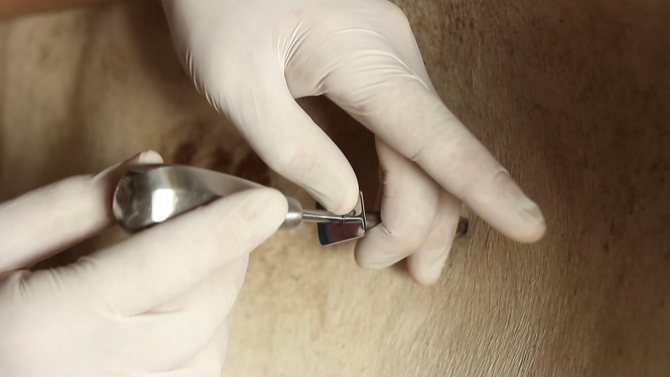

The emerging nerve signals trigger the chewing process by the fact that the ruminant begins to stretch its neck and takes a deep breath. At the same moment, the contraction of the proventriculus chamber, as well as the esophagus, begins. This all causes the displacement of a lump of rough food into the oral cavity of the cow, accompanied by chewing.
The structure of the stomach of a cow suggests the presence of such a reflex as chewing gum, because it helps to prevent the possibility of blockage of the net and the book. In addition, it helps to improve the digestion of feed both in the intestine and in the abomasum. After repeated grinding of coarse dietary fibers by the cow, the feed turns into a homogeneous mass that is easy to digest.
Read more: Eggplant leaves turn yellow in the greenhouse what to do how to fight
The case history of cattle, if the cow does not chew, consists of observing the regularity of his chewing gum. It is important to establish the duration of the cow's chewing gum, its frequency, as well as the time interval between each such act.
In the event that there is a change in the regularity of the chewing gum, its duration or its other parameters, then this is a sure indication that the cow's stomach suffers from atony or the cow does not chew food enough.One of these disorders may be hypotension of the proventriculus, which is expressed in a decrease in the level of blood pressure in these organs.
Painful sensations
The medical history of most animals determines such manifestations of painful sensations when they chew if, the stomach has risen, is a strong stretching of the neck, squatting and moaning when regurgitating a lump of food. Often, such symptoms are provoked by the ingress of foreign objects into the gastrointestinal tract, which irritate and injure the walls of the esophagus, stomach and proventriculus in cattle.
In addition, such a condition in a cow causes the following symptoms:
- A condition with a loss of activity;
- Constant hunchback of the rack;
- Hypotension of the digestive organs;
- Rises to his feet by analogy with a horse.
The medical history of some cows shows that they may experience stomach pains during the dentition process, as well as tympanic and atonic conditions.
Often, the time of changing teeth causes severe pain in the animal's intestinal tract. As teeth grow and replace, all symptoms gradually disappear and the condition when the stomach does not work disappears. After a while, the arisen gastrointestinal tract begins to work normally again.
What to do if a cow's gum disappeared: video
Home {amp} gt; Livestock {amp} gt; Cows {amp} gt; What to do if a cow doesn't have gum
Article rating
Average rating 1.00 (rated by 1 user)
Cattle owners need to be aware of the various diseases of these animals. After all, not everyone can afford a veterinarian, and the situation may require urgency, and the doctor will not be able to get there as soon as possible. The most common diseases that the owner can cope with on their own are problems with the digestive tract in these animals.
The cow has no gum
Cow owners are often frightened by this phenomenon when the cow does not have gum. Such a symptom should immediately disturb, because chewing gum is very important for digestion, its poor work can kill the animal. Re-chewing allows the animal to process solid food well. If this mechanism fails, the cow can get serious damage to the digestive tract, which can even be fatal.
Causes of the disease
So what could be the reason a cow doesn't have healthy gum?
First of all, let's figure out the structure of the animal's digestive tract. The stomach is a gradual enlargement of the esophagus; food enters it, there it accumulates and begins to be digested, that mushy substance into which food turns under the influence of saliva, stomach enzymes, is called chyme.
The peculiarity of a cow's stomach is that, unlike a single-chamber stomach in pigs, a two-chamber stomach in chickens, a cow has as many as four chambers. The complex structure is caused by the fact that cows often eat solid food, so it must be well digested. But it also causes multiple problems with the digestive tract. Consider the chambers of the stomach and their function in the digestive process.
The structure of the stomach
- The first chamber is the largest; in an adult animal, its volume can be up to 200 liters. This chamber is a sac-shaped organ, a rumen, here food is processed with the participation of enzymes produced by ciliates.
- The food enters the next chamber through the mesh, which filters it and lets only the liquid substance into the booklet. At this stage, we need the function of chewing gum, because the cow regurgitates food back until it is digested into liquid.
- The third chamber is called a book, there is no acid in it, and the food is processed by rubbing the walls of this chamber.
- The fourth section is abomasum. This is a glandular chamber.
We have figured out the structure of the four-chambered stomach of an animal, and now we will consider the possible reasons why the cow does not have gum and why she stopped eating (in other words, why she does not regurgitate and does not process food again) or why the stomach has stopped.
If a cow has eaten very wet clover, alfalfa, or other green matter after the rain, rumen swelling may occur. This can be caused by other factors: if the animal has eaten a lot of corn, cabbage; the same effect can occur if you feed a cow with stale or poor quality feed.
The danger lies in the fact that in the process of bloating, gases are formed, they even reach the intestines, because of which the food becomes clogged and cannot pass further, which means that the belching process is also blocked, the cow cannot return food, because of this, the absence of chewing gum. Due to this discomfort, the animal will be lethargic and will begin to refuse to eat.
In order not to confuse tympania with other diseases, you need to know the symptoms: all the actions of the animal are directed to the stomach, the cow can hit it with hooves, often change position, lie down, get up. The animal becomes restless, hums painfully, does not eat food, spits it out. This is accompanied by noticeable weight loss, possibly swelling of the veins in the neck and udder.
If the cow has lost her appetite, you need to be very careful and not delay treatment. It is better not to treat the animal yourself, but to call the veterinarian for help. The doctor must (in acute form) immediately eliminate gases, and then use the necessary substances, such as formalin, turpentine.
Having livestock, you need to clearly know about the responsibility for it. In many cases, cattle owners cope with cow digestion problems on their own. Both cows and calves, as well as other similar small ruminants such as sheep, goats, may stop chewing gum.
The first symptom of stomach problems may be a cow's reluctance to chew gum.
Various problems with the esophagus can occur separately with each section of the stomach.
The stomach is divided into 5 sections for efficient digestion of food:
- scar;
- grid;
- book;
- abomasum;
- intestines.
Tympany
Most of the digestive problems are associated with a blockage in the esophagus and gas in the rumen. This is the so-called "Tympania". The symptom of tympania is the situation when, when feeding on simple grass, the animal overeats.
There is a possibility of “tympanic” appearing when feeding a cow with food that may be stale, have signs of moldiness or frostiness. This feeding is bad. And usually, when a cow chews such feed, it adversely affects the rumen of the stomach, creating an excessive load. Obstruction of the animal's esophagus is also common.
Damp and moldy food can cause bloating
The main reason, as shown by many years of practice, is:
- inattention of the owners themselves;
- ignorance of the rules for feeding the animal with root crops, which need to be cut into large pieces, and not chopped up.
The cow does not have the opportunity to chew a small piece of root vegetable when she chews the gum, into a mushy mixture, and it immediately enters the animal's esophagus, where there is a great risk of blocking the passage of the digestive system.
In this case, an effective method of treatment is to pour a small amount of vegetable oil into the patient's mouth. In order to make it convenient to pour in oil, you need to open the cow's mouth on your own and stick out your tongue as far as possible.
There is also a way to rub the left side of the abdomen of the hungry fossa with a brush or a tourniquet made of straw, or this procedure can be done simply with a fist, massaging the abdomen in the area of the hungry fossa.
To prevent tympania, do not rush to release a hungry cow onto the lush, dewy grass. To prevent the grass from blocking digestion, let her chew the hay. I would also like to remind you that cut the root vegetables into large pieces.
Avoid letting the cow out onto wet grass to prevent swelling.
Atony
Another problem with abnormal contraction of the pre-stomachs associated with the scar is "atony".
The symptoms of this disease are dangerous to livestock and can lead to their death. It is best to seek help from a veterinarian as soon as possible, and not try to be heroic, saving your own wet nurse.
The main signs are that the cow stops chewing gum and, more seriously, refuses to feed. When it is not possible to feed it, the work in front of the stomachs can stop, and the whole process of digestion stops, leading to the death of the cow.
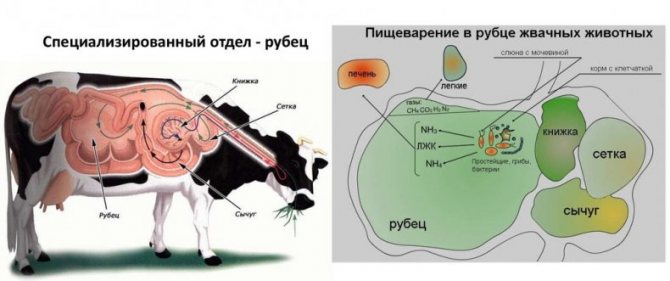

Tincture of cheremitsa, which can be easily purchased at any veterinary pharmacy, helps well against "atony". Measure out two milliliters of cheremitsa tincture and dilute in 400 ml of water. Pour this solution into the mouth of a sick cow. Subsequently, this procedure must be repeated again with an interval of 20 minutes. You can call a veterinarian who will inject a 0.1% carbokhalin solution. They also give two injections with a total dose of one milliliter under the skin, with an interval of 20 minutes.
Read more: Kholmogory breed of cows: characteristics with photos and videos
The main symptom of atony is refusal to eat.
Atony
In such cases, I call a doctor and do a dropper, if on the first day it does not help, then we do it for three days. And then pour in the oil and a few pieces.
We put a stick between the teeth of Marina and tied it to the horns. the cow gnawed a stick and almost a day later belching and chewing gum appeared. and so even the droppers did not help
Washing, massage and ... a magnet help
The aforementioned atony can result from infectious diseases such as foot and mouth disease or botulism. But much more often, chewing reflexes in a cow are weakened or completely stopped due to poisoning. Treatment includes scar massage, gastric lavage, and diet. If you suspect this pathology, you should also urgently contact a veterinarian and in no case use unverified folk remedies. However, the tincture of hellebore diluted in water can be used safely. We give the exact recipe below.
And here, too, the intervention of an experienced doctor is necessary.
The problem is often solved with surgery. But if the object is metal, then an experienced doctor will be able to reach it using a magnetic probe that is inserted into the stomach of the cow.
First aid to a cow when stopping the chewing process involves pouring the following solution through a probe: the cheremita (20 ml) is diluted with 500 ml of water, heated to room temperature. A bottle can be used for oral administration. Caffeine is injected subcutaneously to maintain heart function - 20 ml.
Until the exact circumstances that caused the stomach to stop and cessation of gum are clarified, a starvation diet is prescribed, water is given in unlimited quantities. On the second day, silage and bitter plants such as wormwood can be fed. To reduce the amount of gases, use the drug "Tympanol", which must be diluted with water in a ratio of 1:10. Then the solution is injected into the stomach through a tube.
As preventive measures to regulate gum, it is possible to advise strict adherence to the rules of feeding and caring for animals, maintaining sanitary standards in premises where livestock are kept.
Please like it if you liked the article.
In the comments, keep the conversation going on this topic.
How to solve the problem
When the cow has no gum what to do, they decide urgently.Delay can lead to more serious problems and even death of the animal. Only an experienced cattle breeder will be able to help the cow on his own, but it is better for a beginner to immediately contact a veterinarian. It is necessary to treat a cow based on the diagnosis.
Help for breaking rumination
| Cause | Necessary measures |
| Atony of the scar | · Pour in a solution of sodium hydrochloride; · It is recommended to make subcutaneous caffeine and give Tempanol |
| Acidosis | · The stomach is washed with an alkaline composition; · Put a dropper with saline; · Introduce drugs that restore the heart rhythm; Use enzymes to normalize peristalsis |
| Tympany | · The fermentation process is removed with an aqueous solution of formalin with ichthyol; · Having made a puncture in the right place, release gases and inject with a probe "Creolin", "Tar"; Plant healthy microflora |
| Traumatic reticulitis | Having identified a foreign body, they try to remove it using a magnetic probe. If this method is ineffective, surgical intervention is undertaken |
Important! Before providing veterinary care, the cow is given a stomach massage and transferred to a gentle diet.
ethnoscience
The described problems with digestion in cows are as old as eternity, people have long learned to help animals using the home method. If the cow or calf does not have gum, treatment with folk remedies will ease the suffering. Each method is time-tested, so you can safely apply it:
- for a start, you need to limit the cow's diet, switching only to water for a day - the cow should drink a lot during this period;
- Hellebore tincture will help return the belching (10 ml is diluted in 0.5 liters of water); the procedure is repeated every half hour until the gastric motility is improved;
- to reduce bloating, to establish secretion and peristalsis, you can use chamomile and wormwood tinctures;
- mineral hydrochloride water in the amount of 2 liters perfectly stimulates the digestive system.
Not all products given to an adult cow are suitable for calf treatment. They are recommended herbal decoctions of chamomile and St. John's wort, hellebore, cucumber or cabbage pickle, milk jelly.
The movement of food in the stomach
The stomach of ruminants has an unusual structure. It consists of four sections:
- Scar.
- Grids.
- Books.
- Abomasum.
The food that the cows eat passes through the esophagus into the rumen. After some time (half an hour or an hour after eating), thanks to the reflex contraction of the proventriculus, which is controlled by the vagus nerve, the cow regurgitates a portion of the feed from the rumen back into the oral cavity. The cow carefully processes food and moistens it with saliva, and after about a minute swallows it again.
When the gum stops, there is a short rest period, after which everything repeats. A cow can process up to 60 kilograms of rumen feed during the day. Food chewed and moistened with saliva, getting back into the stomach, is mixed with the rest of the rumen and gradually moves to the abomasum through the mesh and book, thanks to regular contractions of the muscles of the proventriculus. If the cow does not have chewing gum, this indicates a malfunction of the digestive system. There are several reasons why this can happen.
The calf's stomach is arranged according to the same principle - it has 4 chambers, but while the baby feeds on the mother's milk, only one of them is involved - the abomasum. Milk enters there directly from the esophagus and is absorbed in full. This is why calves do not chew gum. All parts of their stomach begin to work a few weeks after birth, when the calves are fed with hay.
Arrangement of the digestive system of cattle
As soon as the stomach of a young ruminant begins to work at full strength, the same processes occur there as in the guts of an adult cattle. The swallowed feed passes into the rumen, then into the net, which passes small pieces into the book, and then into the abomasum.The resulting gases push (belch) large food back into the mouth, and the calf chews them again until they are small.
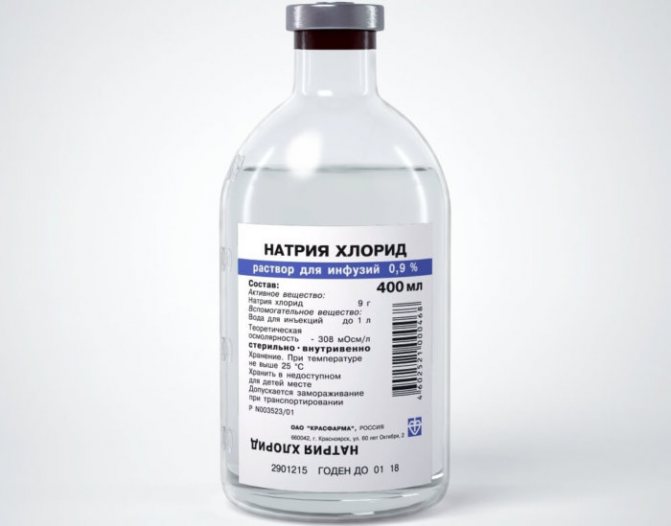

The chewing process for each portion lasts no more than one minute. After that, the calf swallows chopped food moistened with saliva (by the way, about 100 liters of saliva is released per day), and regurgitates the next large piece. Easily digestible food is in the rumen for only one and a half to two hours. And the gross ones can travel in the stomach for several days, they regurgitate and chew more than once.
As soon as this complex process is disrupted, you need to sound the alarm and find out why the calf has gone chewing gum. After all, this symptom can be a harbinger of a serious illness.
Signs of the disease
The first thing that catches your eye when tympanum is a large belly in a cow. A lot of food, gases and foam accumulates in the rumen: the stomach cannot cope. Other symptoms of the disease are noted:
- the abdominal cavity on the left increases;
- the peritoneum is rigid;
- when palpating the abdomen, the animal feels pain; hums in pain;
- the animal becomes restless: waving its tail, hitting its hind limbs on the stomach;
- one of the main symptoms of tympania is the absence of chewing gum;
- there is difficulty in breathing; breathing is shallow.
In acute forms of tympania, the cow's condition deteriorates sharply, the abdomen swells up. The production of gases and foam can already occur during walking. In rare cases, symptoms are only visible after a few hours. The gradual development of tympania occurs in the chronic form, when papillomatosis or other infectious disease progresses in the body. What to do if a cow swells after a walk? What treatment is prescribed for cattle?
Tympany
Pregnant cows are treated with a diet
Of particular concern is the situation when the cow loses the chewing reflex during pregnancy. And you need to clearly understand what to do and how to treat if the cow does not have gum at such a difficult moment. After all, any wrong actions can harm the unborn calf.
Remember that pregnant cows chew at the same intensity as normal animals. That is, the physiological state does not affect the chewing process. However, when calving is already close, the fetus has a rather large size and weight (25-50 kg). Therefore, in some cases, it can put pressure on the internal organs of a cow and disrupt the work of any part of the stomach. Usually, they try not to apply any radical measures to provide assistance, they are limited to a special diet.
Other reasons that stop the chewing process in cows include mechanical damage to the jaw and nervous diseases. In the first case, it will be noticeable that the cow is reluctant to eat, as she is in pain. Usually, a visual examination of the veterinarian immediately finds a solution to eliminate this pathology. In the second case, a comprehensive examination of the animal is required.
Why a cow does not chew gum after calving
After the calves are born, the cow may stop chewing gum for certain reasons. Let's consider them.
Milk fever
Childbirth paresis is a rather serious disease in which the body temperature drops near the base of the tail and horns. In this case, the animal cannot go to the toilet, the milk flow rate sharply decreases.
It is difficult for the cow to lie down, so she takes an S-shaped posture. When these symptoms appear, it is urgent to inject 10% calcium chloride (200 ml) and glucose (200 ml) intravenously, and also pump the udder with air.
If, after calving, the cow begins to lick the calf, then at this moment she can swallow amniotic fluid or eat the afterbirth. As a result, the digestive tract is disrupted.
To eliminate this problem, it is recommended to give the cattle decoctions and infusions of hay, black tea mixed with a solution of alcohol - this will help disinfect the stomach.
It is also necessary to lay small pieces of old bacon, cut into thin slices, by the cheeks of the animal. This will provoke a gag reflex and eventually return the gum.
Lack of chewing gum in cows can be the result of difficult labor. As a result of the movement of the fetus inside the body in a heifer or cow, the process of displacement of internal organs begins. Often this process leads to disturbances in the digestive tract.
Methods for treating gum in a cow:
- a special diet is assigned, which consists of sprouted grain and compound feed;
- make fortified injections after calving;
- if necessary, the veterinarian prescribes complex treatment with immunomodulatory drugs.


You can prevent such consequences if you provide the cow after calving with proper housing conditions - proper and balanced nutrition, vitamins and minerals, keeping on a horizontal floor and cleanliness in the room.
Milk fever
It is difficult for the cow to lie down, so she takes an S-shaped posture. When these symptoms appear, it is urgent to inject 10% calcium chloride (200 ml) and glucose (200 ml) intravenously, and also pump the udder with air.
Read more:
- Diseases and pests of hydrangea paniculata and their treatment
- How to store cut hydrangeas in a vase. Hydrangea how to care
- Cut in a cow after calving treatment of the disease symptoms
- Cattle skin diseases: symptoms and treatment

